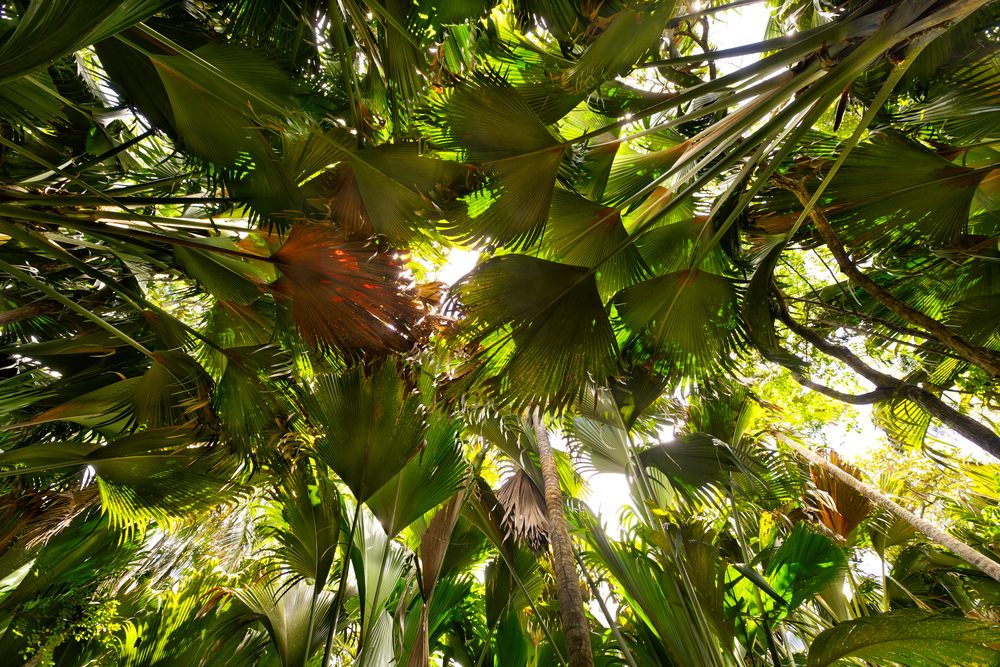The Giant, Suggestive Seeds of the Seychelles ‘Love Nut’
They’re 35 pounds, resemble human buttocks, and are irresistible to poachers.

If you were to go looking for photos of paradise, chances are good you would come across pictures of the Seychelles islands. Sitting on a white sand beach, watching the sun ascend over turquoise water, it’s easy to imagine people landing in the Seychelles in the 16th century, and quickly deciding to never leave.
The Seychelles (officially the Republic of Seychelles) is a rocky archipelago in the Indian Ocean, northeast of Madagascar. The beauty of the islands is so heavenly it’s almost cliché. All the standards are here. Clear water. White sand. Warm wind. But the true pride of the Seychelles is an endangered ancient palm tree called the coco de mer.
A strange case of island gigantism, coco de mer trees thrived during periods in which other giant species around the globe died off. Sixty-five million years ago mass extinction wiped out dinosaurs and countless other species, but not the coco de mer. Today, the Seychelles islands of Praslin and Curieuse are home to the only two remaining wild populations of these rare palms.

The trees themselves can hit 100 feet tall, but it’s not their height that sets them apart, it’s what they produce. The inedible fruit of the coco de mer look like giant green coconuts weighing 75 pounds. Inside these massive husks grows a seed weighing more than 35 pounds—the largest in the plant kingdom.
At more than a foot and a half in diameter, size is only part of the allure of these unique seeds. In addition to weighing as much as a toddler, coco de mer seeds look like voluptuous human behinds. Split into two symmetrical sections with bulbous cheeks on either side, their image graces everything in the Seychelles, from t-shirts to government trucks. Nicknamed the love nut, in local Creole they’re coco fesse, the bum nut.

On the Island of Praslin is the Vallée de Mai Nature Reserve, home to the largest concentration of coco de mer trees in the world. The park feels like a Triassic playground. Standing under huge coco de mer with fanning leaves 30 feet long and 15 feet wide, it’s easy to imagine dinosaurs hiding in the shadows. Above the canopy the sun blazes, but in the forest it’s cool and damp.
Numerous species here exist nowhere else in the world. The Seychelles Black Parrot, the Bronze Gecko, the White Slug. Each of them relies on the coco de mer in one way or another. The parrots nest in the hollow trunks of dead coco de mer, the geckos and slugs eat its pollen.
“Coco de mer is a keystone species,” says Vallée de Mai Site Manager Marc Jean-Baptiste. “Without coco de mer, this forest would collapse.”
Five other endemic species of palm call the Vallée de Mai home, but none of them capture the hearts of locals and tourists like the coco de mer.

A slow growing species, coco de mer coconuts take seven years to reach maturity. Once they fall they need another two years for the husk to rot away and the seed to sprout. Coco de mer trees might need 40 years to reach adulthood, though some trees may begin reproducing as early as 11. By comparison, a traditional coconut seed takes six years to reproduce. A banana plant takes two.
According to Jean-Baptiste, the coco de mer’s size makes it a natural predator. “Young coco de mer trees do not need too much light to grow,” he says.
When the massive leaves of adult trees block the sun, he explains, it doesn’t bother the young coco de mer, but it might keep neighboring plants from growing and competing for resources. Adult trees are also very efficient at collecting rainwater. The leaves funnel most of the rain that lands on them to their trunks, leaving little for less aggressive plants below. And when the giant leaves fall off, the sheer size of coco de mer seeds means the trees they sprout are strong enough to push their way through, while smaller neighboring plants may not be.
But while the coco de mer has proved robust enough to survive centuries of evolutionary hazards, the dangers it faces are increasing.

The kernel inside coco de mer seeds is considered an aphrodisiac in parts of Asia, fetching upwards of $100 per kilo. Poachers take coco de mer seeds from the forest before they can sprout, in order to sell the kernel on the black market. Poaching poses a long-term risk to coco de mer populations, but looming effects of climate change could prove even more alarming.
“My biggest fears for the coco de mer are poachers, fire, and disease,” Jean-Baptiste says.
Dr. Frauke Fleischer-Dogley is CEO of the The Seychelles Island Foundation, the public trust that manages the Vallée de Mai. She says rising temperatures have meant longer dry seasons in the Seychelles, and longer dry periods increase risks of fire. “Warmer temperatures around the globe can also lead to the spread of diseases that have difficulty in cooler weather,” she says.
Some 40 percent of Praslin has already been affected by fires. If fires get worse, or if a combination of fire and disease were to hit both Praslin and Curieuse, what remains of native coco de mer forests could be decimated.
For now though the trees remain, growing slow in their island paradise as they have for thousands of years.









Follow us on Twitter to get the latest on the world's hidden wonders.
Like us on Facebook to get the latest on the world's hidden wonders.
Follow us on Twitter Like us on Facebook